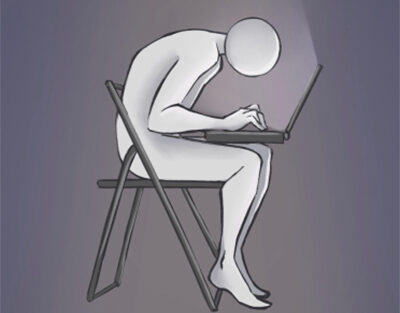What is it/Why does it happen?
As a society, we sit. We sit at our kitchen tables while eating, and couches while watching tv. We sit in our cars during our errands, or at the movies for entertainment. Most notably, we sit in our schools for our learnings, and at our desks for our work, We sit so much, that surely it can’t be terrible for us, right?
Well, the association between sitting and low-back pain is rather well documented at this point. Muscular imbalances between our stretched-out gluteals & shortened psoas may lead to a myriad of joint restrictions, strained spinal discs, and other biomechanical issues. However, that’s just the tip of the iceberg. What about our upper backs, and our necks?
Rare do we sit, without our attention being held by something infront of us. Phones, laptops, movies, shows, food, or perhaps company across the table – these things grab our attention as we focus on them. As we become more and more focused on whatever our distractions are, it’s not uncommon to begin experiencing a forward-head posture – where we unconsciously ‘lean in’ to whatever it is we’re focusing on. This forward-shift in location of our 11lbs head (equal weight to a bowling ball, by the way) then must be supported by our neck & upper back musculature, until we become aware of our postural issues and correct ourselves until we become focused again. This cycle eventually leads to what we term as “Upper-Cross Syndrome”, which has also earned the nickname “Student Syndrome”, for being very common in the student population.
What should chronic-sitters expect?
Upper-Cross Syndrome is extremely prevalent in both the student & desk-worker populations. Patients are usually first made aware of it as a gradual onset of dull, achy pain along the back of their necks & upper back. If left unaddressed, this dull ache exacerbates into difficulty sleeping, headaches, or carpal-tunnel like numbness/pain in the arms and hands.
Treatment methods and exercises/modification
The good news here is that Upper Cross Syndrome – like other postural-based issues – have an excellent prognosis (recovery) with chiropractic & multidisciplinary care. In these scenarios, both a passive and an active component of treatment are essential to obtain maximum relief, quickly!
Osseous Manipulation (Chiropractic Adjustments) should be at the forefront of treatment for Student Treatment. Adjustments to the neck & upper back help to restore proper biomechanical movement & functioning to the targeted areas, as well as provide immediate relief from feelings of constriction & tightness. Following this, incorporation of massage or other soft-tissue therapy to target the neck and upper back musculature compounds the relief. These two things alone are sufficient to eliminate the symptoms of Upper Cross Syndrome within a short treatment session!
Following these treatments, incorporating a few simple exercises/stretches into a patient’s daily routine will help to prolong the relieving effects from adjustments, or delay the onset of discomfort from poor posture:
Brügger’s Exercise, shown above, is a simple exercise that stretches the most commonly affected muscles of those with Upper-Cross Syndrome. It can be incorporated into the work routine near-seamlessly, as it’s done from a seated position. Begin by sitting at the edge of your chair & tuck your chin in, as if nodding “yes”. Rotate your arms & shoulders out from your body; turn your palms forward, and then further out to your sides. Pull your shoulder back, while protruding your chest forward. Hold these position for as long as you feel a healthy stretch!
A second, highly-recommended exercise helps to improve the mobility of the spinal joints in the upper back, specifically referred to as your “thoracic”-spine. Shown above, the “Cat-Camel” exercise involves slowly transitioning from the top position, to the bottom position, and back. Begin from a quadruped (on all fours) position, with your head & buttock up, stomach & chest lowered. From here, begin slowly “pushing your upper-back up to the ceiling”, while lowering your head & rounding your low-back. Once you have gone as far as you can, hold for the stretch, and then slowly return to the original position. Repeat.
If a person experiencing Student Syndrome begins with these treatment methods, they will notice significant improvement and progress towards complete recovery. However, the issue with many postural-based syndromes is their tendency to reoccur without consistent intervention! Remember to take regular movement breaks from your work/studies, and consult with your healthcare provider regarding potential ergonomic alterations to your workplace.


